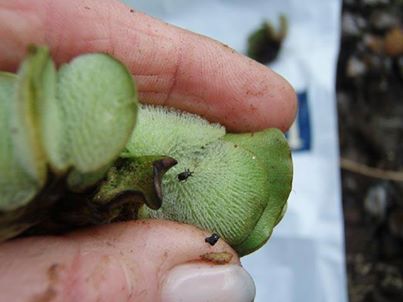
Severe winter temps this year killed off bulk of weevil population in northern parishes
Unusually cold temperatures in the northern parishes are expected to have killed 90 percent of the salvinia weevils used to combat the invasive aquatic plant giant salvinia, which is clogging waterways across Louisiana.
That reality has experts from the Louisiana Department of Wildlife and Fisheries along with LSU AgCenter weed scientist Dearl Sanders and fellow scientists Seth Johnson and Stephen Micinski, searching for weevils that can survive the winter in north Louisiana as they do in the southern parishes.
“We know that all of the weevils that are in the United States came into this country through the quarantine system in Mission, Texas, and they probably were selected out for heat-tolerant weevils,” Sanders said.
That has worked well for the giant salvinia control efforts in South Louisiana, said LSU AgCenter entomologist Seth Johnson.
But in North Louisiana cold tolerance is what’s needed.
“In South Louisiana, the salvinia weevil is what you might call a silver bullet,” Johnson said. “The giant salvinia plant isn’t totally gone, but its presence seems to be just enough to support the weevils that are controlling it.”
LSU AgCenter’s main role in the current project that began in January is to search for weevils that are more adapted to the northern part of the state.
Weevils reproduce rapidly, which is great for this project.
“We’ve used the one nursery site in Southern Louisiana for the distribution of weevils all over the state,” Johnson said. “So we’ll probably need to establish a nursery in North Louisiana and follow the same model.”
LSU AgCenter researcher Stephen Micinski, who works at the Red River Research Station in Bossier Parish, said he has found some weevils that survived the winter in Shreveport’s Cross Lake and some have also been found in Texas.
The LSU AgCenter has been involved in the giant salvinia eradication program since the weed was found at Toledo Bend in 1999.
Since this invasive species was first identified, both LDWF and the LSU AgCenter have been looking for ways to control it.
LSU AgCenter Associate Vice Chancellor Rogers Leonard said Louisiana is fortunate to have a team of scientists from both agencies with expertise to evaluate and recommend a range of management strategies.
“Collaborative research and outreach efforts from several agencies will be necessary to reduce the impact of this invasive species in Louisiana’s waterways,” Leonard said. “The weevil is just one example of a sustainable and environmentally- friendly control measure. We are hopeful that as Louisiana scientists are provided more opportunities to expand research, the current system of using the weevil can be improved.”
The initial estimate of the infestation was about 400 acres in 1999, but the number quickly escalated to more than 70,000 acres in 20 Louisiana lakes by 2010.
By 2009, scientists with the Louisiana Department of Wildlife and Fisheries and LSU AgCenter were combining their efforts in an attempt to control giant salvinia with the salvinia weevil.
LDWF Secretary Robert Barham said there has been much success in controlling the giant salvinia in South Louisiana, but the results in North Louisiana have him concerned.
“Not only is giant salvinia endangering the ecology of our lakes, it’s also threatening the economies of lakeside communities that depend on fishing, boating and tourism,” Barham said.
It is important to find ways to introduce cold-tolerant weevils into the waterbodies of North Louisiana, he said.
“It is our hope that focusing weevil research and development in this direction will provide an effective, efficient giant salvinia control measure for all lakes in North Louisiana,” Barham said. “We also want to encourage concerned anglers and other resource users to assist in our control efforts by inspecting and cleaning their boats, trailers, personal watercraft intakes and other equipment of all aquatic vegetation before leaving an infected area.”
Giant salvinia is native to Brazil and had spread to many areas of the world in the 1950s and 1960s.
“The weed came here as part of the water garden trade,” Sanders said. “Once people realized the weed was taking over their ponds, some pulled it up and threw it in ditches and it ended up in the waterways.”


